1)Bacillus Cereus
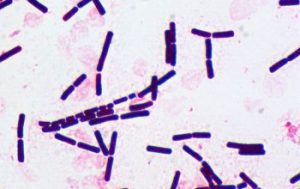
Bacillus cereus or B. cereus is an aerobic spore-forming bacterium that is commonly found in soil, on vegetables, and in many raw and processed foods. This bacterium can cause illness characterized by diarrhea and the other, called emetic toxin, by nausea and vomiting. B. cereus food poisoning may occur when foods are prepared and held without adequate refrigeration for several hours before serving
Common Name of Illness
- B. cereus food poisoning
Sources
Temperature abuse for variety of foods particularly cooked meat vegetables, boiled or fried rice, vanilla sauce, custards, soups, and raw vegetable sprouts.
Onset time after ingestion
- Diarrheal (4-16 hours)
- Emetic, vomiting (1 hour- 5 hour)
Signs & symptoms
- Diarrheal (Watery diarrhea, abdominal cramp)
- Emetic (nausea, vomiting)
Safety Tips
- Drink plenty of fluids and get rest.
- Consult your doctor.
- Keep hot foods hot (over 60°C)
- Keep cold foods cold (5°C or under)
- Refrigerate promptly.
[collapse]
2)Campylobacter jejuni
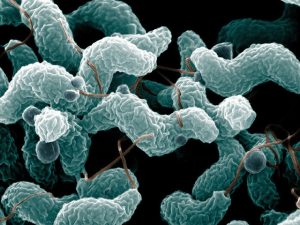
Campylobacter jejuni is a microaerophilic, very small, curved, thin and thermophilic species (optimum 42°C)
Common Name of Illness
- Campylobacteriosis
Sources
- Consumption of food and water contaminated with untreated animal or human waste include unpasteurized milk, undercooked poultry, meats, poultry, shellfish, fruits, and vegetables
Onset time after ingestion
- 2-10 days
Signs & symptoms
- meningitis
- pneumonia
- miscarriage
- produce enterotoxin causing a severe diarrhea, cramps, fever, and vomiting; diarrhea may be bloody
Safety Tips
- Always cook meat, especially poultry, to safe minimum temperatures
- Keep raw meat, especially poultry, separate from other foods
- Do not drink raw or unpasteurized milk.
[collapse]
3)Clostridium botulinum
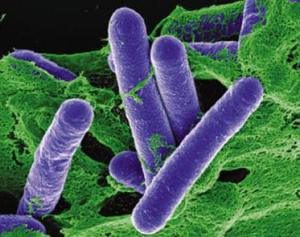
Clostridium botulinum is anaerobic, rod-shaped sporeforming bacterium. Under certain conditions, these organisms may grow in foods producing toxin (neurotoxin)
Common Name of Illness
- Botulism
Sources
- There are 3 types of botulism.
1)Food-borne
Food-borne botulism occurs when the bacteria grow in the food and produce toxins that are not destroyed by the cooking process. Eating these contaminated foods can cause botulism. The bacterial growth happens most often in foods with low acidity such as:
- home-preserved fruits and vegetables
- potato salad
- minced garlic in oil and also associated with canned foods
- improperly cured meat product, baked potatoes in aluminum foil
- fermented uncooked fish or marine product.
Symptoms are severe and usually develop 12 to 36 hours after eating contaminated food. This form of botulism can be fatal, and about 5 to 10 per cent of adults who acquire food-borne botulism will die.
2)Intestinal
Intestinal botulism occurs when spores from the bacteria are ingested and then multiply in your intestinal tract and produce toxins. The spores are spherical structures produced by bacteria. These spores can survive boiling and extremes of cold and drying, and can develop into bacteria if in suitable growing conditions. Children under 12 months are most susceptible to infection, but adults with gastrointestinal problems can also be at risk. However, in most adults, even if the spores are ingested they do not make you ill because your body’s natural defenses stop the bacteria from multiplying and producing toxins. Intestinal botulism is most commonly associated with eating raw honey.
3)Wound
This form of botulism is rare and occurs when bacterial spores in soil or gravel get into an open wound and reproduce, then release toxins. Symptoms typically develop between 4 days and 2 weeks after the bacterial spores enter the wound.
Sign & Symptoms in adults
- diarrhoea
- vomiting
- constipation
- blurred vision
- difficulty in speaking
- swallowing
- breathing
- dry mouth
- weakness
- fatigue
- paralysis of the muscles.
Signs and symptoms in infants
- constipation
- weak cry
- loss of head control
- loss of appetite
- breathing difficulties
- reduced movement of limbs and weakness.
- Death may result from paralysis of the breathing muscles.
Safety tips
- Cook and reheat foods thoroughly to safe temperature
- keep cold food below 4 °C and hot food above 60 °C.
- Throw away canned foods that are damaged, out of date or show signs of spoilage.
- Pay attention to hygiene, pressure, temperature, cooking time, refrigeration and storage.
- Wash any wounds with antibacterial soap
- Do not feed honey to babies less than 12 months.
[collapse]
4)Clostridium perfringens
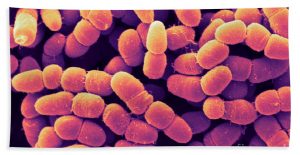
Clostridium perfringens is anaerobic and spore forming bacterium. Food poisoning caused by Clostridium perfringens may occur when foods such as meat or poultry are cooked and held without maintaining adequate heating or refrigeration before serving
Common Name of Illness
- Perfringens food poisoning
Sources
- Time and/or temperature-abused foods. That’s why outbreaks of these infections are usually linked to institutions (such as hospitals, school cafeterias, prisons, and nursing homes) or events with catered food.
Sign & Symptoms
- Watery diarrhea
- intense abdominal cramps (not fever or vomiting)
Safety Tips
- Thoroughly cook foods, particularly meat, poultry, and gravies, to a safe internal temperature.
- Keep food hot after cooking (above 60).
- Refrigerate food and use a food thermometer.
- Divide leftovers into shallow containers and refrigerate immediately.
- Do not let them cool on the counter.
[collapse]
5)Escherichia coli
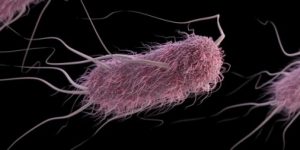
4 categories of E. coli
1) Enterotoxigenic E. Coli (ETEC)
- watery diarrhea
2) Enteroinvasive E. coli (EIEC)
- ulceration and inflammation
3) Enteropathogenic E.coli (EPEC)
- infection in infants and young children
4) Enterohaemorrhagic E.coli (EHEC)/ Shiga toxigenic E. coli (STEC)
- The infection produces toxic substances that destroy red blood cells, causing kidney injury or otherwise called hemolytic uremic syndrome (HUS). Then, E. coli O157:H7 makes a toxin called Shiga toxin and is known as a Shiga toxin-producing E. coli (STEC)
Sources
- Contaminated food, especially undercooked ground beef, unpasteurized (raw) milk and juice, soft cheeses made from raw milk, and raw fruits and vegetables (such as sprouts).
- Contaminated water, including drinking untreated water and swimming in contaminated water. Animals and their environment: particularly cows, sheep, and goats.
- If you don’t wash your hands carefully after touching an animal or its environment, you could get an E. coli infection.
Sign & Symptoms
- Bloody diarrhea
- abdominal pain
- vomiting.
- More common in children 4 years or younger. Can lead to kidney failure.
- Symptoms of HUS include decreased urine production
- dark or tea-colored urine
- facial pallor.
Safety Tips
- Avoid eating high-risk foods, especially undercooked ground beef
- Use a food thermometer to make sure that ground beef has reached a safe internal temperature.
- unpasteurized milk or juice, soft cheeses made from unpasteurized milk, or alfalfa sprouts.
- Maintain personal hygiene such wash hands regularly.
[collapse]
6)Listeria monocytogenes
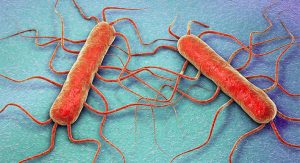
Listeria monocytogenes is anaerobic and non spore bacteria. Listeria is unlike many other germs because it can grow even in the cold temperature of the refrigerator. Listeria is killed by cooking and pasteurization.
Common Name of Illness
- Listeriosis
Sources
- Ready-to-eat food
- unpasteurized (raw) milk and dairy products, soft cheese made with unpasteurized milk, such as queso fresco, Feta, Brie, Camembert, refrigerated smoked seafood and raw sprouts.
Sign & Symptoms
- Fever
- stiff neck
- confusion
- weakness
- vomiting
- diarrhea
Who’s at risk
- Older adults which may develop meningitis.
- pregnant women which may have mild flu-like illness, and infection can lead to premature delivery or stillbirth.
- people with weakened immune systems
- people with certain diseases, such as HIV/AIDS or other autoimmune diseases, cancer patient, alcoholism and diabetes persons.
Safety tips
- Do not drink raw (unpasteurized) milk, and do not eat foods that have unpasteurized milk in them.
- Wash hands, knives, countertops, and cutting boards after handling and preparing uncooked foods.
- Rinse raw produce thoroughly under running tap water before eating.
- Keep uncooked meats, poultry, and seafood separate from vegetables, fruits, cooked foods, and ready-to-eat foods.
- Thoroughly cook raw food from animal sources, such as meat, poultry, or seafood to a safe internal temperature.
[collapse]
7)Salmonella

Salmonella is non spore forming bacterium.
Common Name of Illness
- Salmonellosis
Sources
- Eat contaminated, undercooked meat (most commonly chicken), eating contaminated raw or undercooked eggs, eating food that has been cross-contaminated with Salmonella from raw foods (especially meats, poultry and eggs)
- Handling pets, other animals, raw meat and pet meat, drinking water that has been contaminated, usually by animals or sewage.
- Person-to-person spread can happen if you come into contact with microscopic amounts of faeces (poo) from an ill person. Such spread may occur directly by close personal contact, or indirectly by touching contaminated surfaces such as taps, toilet flush buttons, toys and nappies.
Sign & symptoms
- diarrhea
- stomach cramps
- nausea
- vomiting
- fever
- headache.
Safety Tips
- Properly cooked meat, poultry especially chicken to safe temperature.
- Separate raw and cooked food.
- Wash hand regularly and use safe water material.
[collapse]
